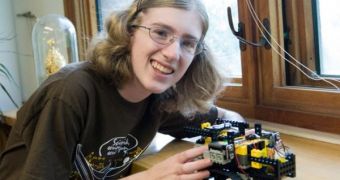This May, at the Intel International Science and Engineering Fair's Public Day, children of all ages gathered around what looked like an average LEGO-based robot, devised by University of California in San Diego (UCSD) student Anna Kornfeld Simpson. However, the machine was anything but ordinary, as evidenced by the fact that its owner and builder was awarded the First Place in Electronics and Electromagnetics, as well as the Patricia Beckman Project of the Year Award. The devices mounted on the robot make it an ideal and extremely cheap application for detecting dangerous chemicals in toxic environments, thus eliminating the need for the human factor, LiveScience reports.
An array of the small robots could also be used to detect chemical spill, and to react to them. They could be wired in such a manner that they would relay information back to their human controllers, who could then act on the knowledge. “This technology has applications in industry, security, counter-terrorism, environmental sensing and maybe even Mars exploration. By removing people from the potential danger of searching for and detecting chemicals in hazardous situations, an array of inexpensive robots could help preserve safety and save lives,” says Kornfeld Simpson.
She explains that the sensors she placed on the robot upon construction are very basic, and yet highly efficient. They can indicate the presence of a volatile organic compound (VOC) by changing the color of a porous silicon chip, which is sensitive to chemicals. In addition to the chip, the sensors include only a few other components, such as an LED, photodiodes, op-amps and resistors. A fan is also included in the design. Its purpose is to suck up air in the chip chamber, where light is shone on it from the LED. The chip then lights up with various colors, indicating the type of contaminant it detected.
“The technology that makes my robotic sensor possible was developed by my mentor, Michael Sailor of UCSD. His laboratory, funded in part by an NSF grant, develops porous silicon chips that change color when chemicals get into the pores. Sailor's many post-docs, graduate and undergraduate students explore applications for these chips in areas like medicine, environmental sensing, and chemical detection. When I first met with the group as a freshman in high school in the spring of 2007, I was intrigued with the idea of putting his chip onto a robot,” the student concludes.

 14 DAY TRIAL //
14 DAY TRIAL //